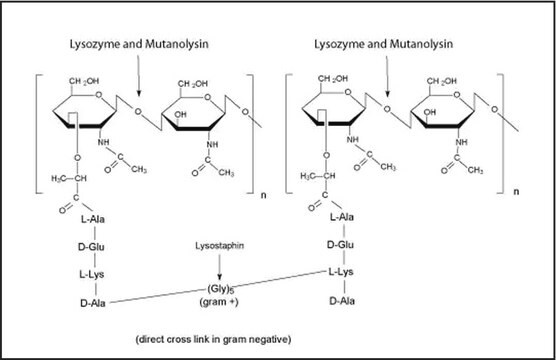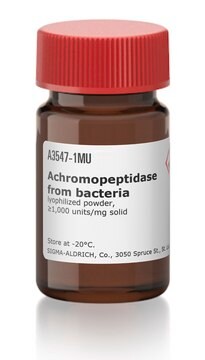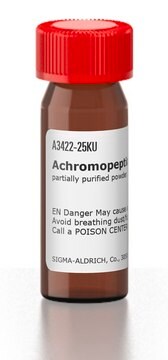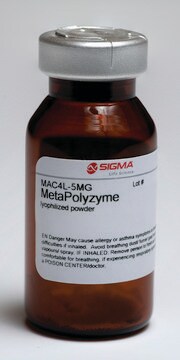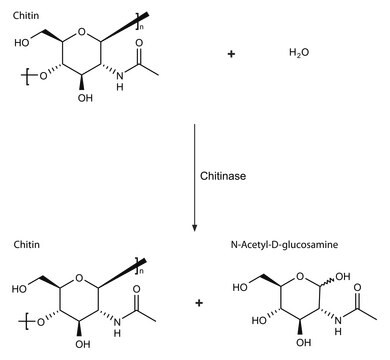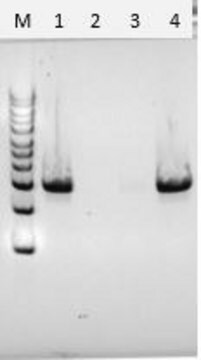SAE0196
Achromopeptidase from bacteria
free of DNA contaminants, suitable for Microbiome research
Synonym(s):
Bacterial Protease
Sign Into View Organizational & Contract Pricing
All Photos(1)
About This Item
UNSPSC Code:
12352204
NACRES:
NA.54
Recommended Products
biological source
bacterial
Quality Level
form
lyophilized powder
specific activity
≥1000 U/mg
feature
DNA free
technique(s)
DNA extraction: suitable
suitability
suitable for cell lysis
application(s)
cell analysis
shipped in
ambient
storage temp.
−20°C
General description
Achromopeptidase is useful for lysis of Gram-positive bacteria that are resistant to lysozyme, as well as Gram-negative organisms. Achromopeptidase has been shown to contain two bacteriolytic proteases. This product is free of detectable microbial DNA and is suitable for microbiome research
Application
Achromopeptidase is useful for lysis of Gram-positive bacteria that are resistant to lysozyme, as well as Gram-negative organisms. Achromopeptidase has been shown to contain two bacteriolytic proteases.
The study of microbial communities has been revolutionized in recent years by the widespread adoption of culture independent analytical techniques such as 16S rRNA gene sequencing and metagenomics. Since DNA contamination during sample preparation is a major problem of these sequence-based approaches, DNA extraction reagents free of DNA contaminants are essential. This product undergoes strict quality control testing to ensure the absence of detectable levels of contaminating microbial DNA using 35 cycles PCR amplification of 16S and 18S rDNA using universal primer sets.
The study of microbial communities has been revolutionized in recent years by the widespread adoption of culture independent analytical techniques such as 16S rRNA gene sequencing and metagenomics. Since DNA contamination during sample preparation is a major problem of these sequence-based approaches, DNA extraction reagents free of DNA contaminants are essential. This product undergoes strict quality control testing to ensure the absence of detectable levels of contaminating microbial DNA using 35 cycles PCR amplification of 16S and 18S rDNA using universal primer sets.
Biochem/physiol Actions
Achromopeptidase is a lysyl endopeptidase that has a molecular weight of approximately 27 kDa. Optimum pH is 8.5-9.
Features and Benefits
Contains two bacteriolytic proteases for efficient lysis of Gram-positive bacteria and Gram-negative organisms
Free of detectable microbial DNA, ensuring the accuracy of metagenomics and other culture-independent sequencing methods
Undergoes strict quality control testing to ensure the absence of detectable levels of contaminating microbial DNA
Optimum pH of 8.5-9 allows for use in a wide range of microbiome studies
Free of detectable microbial DNA, ensuring the accuracy of metagenomics and other culture-independent sequencing methods
Undergoes strict quality control testing to ensure the absence of detectable levels of contaminating microbial DNA
Optimum pH of 8.5-9 allows for use in a wide range of microbiome studies
Unit Definition
One unit will lyse 0.4 μg of Micrococcus lysodeikticus per minute by turbidimetric detection at 600 nm when suspended in buffer at pH 8.0 at 37 °C.
Signal Word
Danger
Hazard Statements
Precautionary Statements
Hazard Classifications
Resp. Sens. 1
Storage Class Code
11 - Combustible Solids
WGK
WGK 3
Flash Point(F)
Not applicable
Flash Point(C)
Not applicable
Choose from one of the most recent versions:
Certificates of Analysis (COA)
Lot/Batch Number
Sorry, we don't have COAs for this product available online at this time.
If you need assistance, please contact Customer Support.
Already Own This Product?
Find documentation for the products that you have recently purchased in the Document Library.
Our team of scientists has experience in all areas of research including Life Science, Material Science, Chemical Synthesis, Chromatography, Analytical and many others.
Contact Technical Service